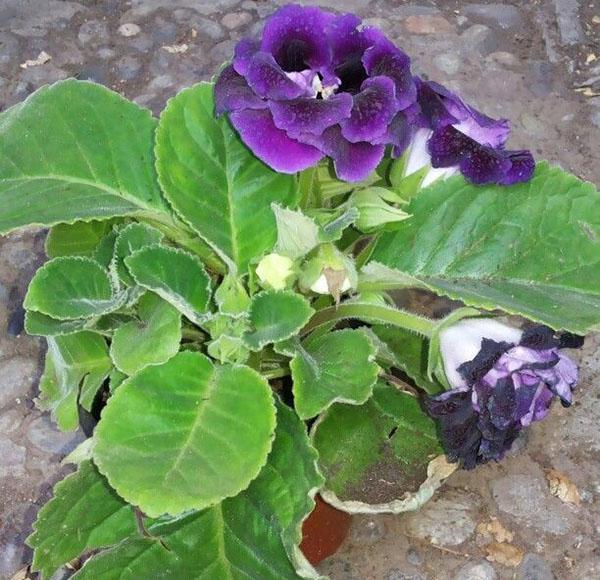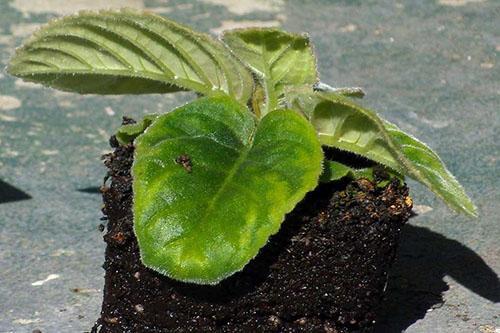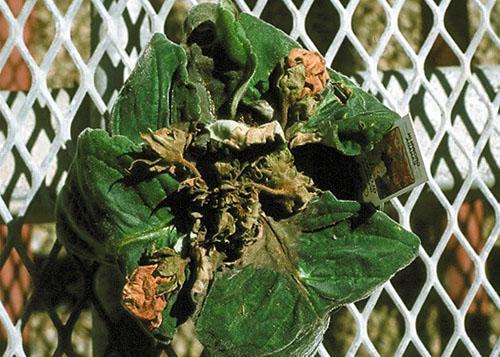We study gloxinia leaf diseases and methods of treatment
 To the advantages of gloxinia, flower growers rightfully include not only large bell flowers, but also velvety foliage, which forms a lush aerial part of the plant. If there is gloxinia in the home collection, leaf diseases and the treatment of their consequences can take a lot of time from the grower. Fungal and bacterial infections, care errors and pests threaten the flower with serious damage and even death.
To the advantages of gloxinia, flower growers rightfully include not only large bell flowers, but also velvety foliage, which forms a lush aerial part of the plant. If there is gloxinia in the home collection, leaf diseases and the treatment of their consequences can take a lot of time from the grower. Fungal and bacterial infections, care errors and pests threaten the flower with serious damage and even death.
Some diseases of gloxinia and its leaves cannot be defeated. Therefore, it is much more useful and easier, knowing the signs of diseases, to pay attention to their prevention.
Gloxinia leaf fungal diseases and their treatment

More often than others, phytophthora fungi are seduced by gloxinia. Gloxinia leaf disease appears as brownish-brown spots on greenery, petioles, and stems. In dry air, the affected areas dry out quickly, the leaves, and then the entire aerial part, die. With high humidity, the tissues under the fungus rot, soften and also die off.
Treatment late blight rarely gives positive results, and a viable fungus can remain active for several years. Therefore, it is important to prevent the onset of the disease by directing all efforts to prevention.
- All purchased tubers are treated with fungicides before planting.
- The soil for planting is heated in the oven.
- Gloxinia plants and the soil under them are sprayed with a solution of fingicide or phytosporin several times a year.
 If gloxinia leaf disease, as in the photo, nevertheless made itself felt, the affected specimens are not only treated with an antifungal agent and cleaned of drying leaves. Gloxinia are quarantined, separated from healthy plants, and then sprayed with a systemic fungicide for prophylaxis. The treatment is repeated a week later.
If gloxinia leaf disease, as in the photo, nevertheless made itself felt, the affected specimens are not only treated with an antifungal agent and cleaned of drying leaves. Gloxinia are quarantined, separated from healthy plants, and then sprayed with a systemic fungicide for prophylaxis. The treatment is repeated a week later.
These same measures are effective in treating gloxinia with leaf diseases caused by other fungi. Such diseases include:
- true and downy mildew;
- anthracnose;
- axochytosis;
- septoria and other infections.
Indoor plants are at greatest risk of infection if safety measures are not followed during planting, during summer outdoor maintenance, as well as careless care.
 An alarming symptom that speaks of a fungal disease of gloxinia, as in the photo, is the formation of an unusual whitish plaque, brown, gray or reddish spots, foci of drying and dying tissue.
An alarming symptom that speaks of a fungal disease of gloxinia, as in the photo, is the formation of an unusual whitish plaque, brown, gray or reddish spots, foci of drying and dying tissue.
Treatment of such diseases is advisable with a low degree of damage, if the infection has captured most of the stems and leaves, you will have to part with gloxinia.
Viral and bacterial diseases of gloxinia
 The bacteria that cause gloxinia disease can be transferred to plants from the soil, from the tools used during the transplant, or from a used pot. As a result of bacterial infection, both the aerial part and the tuber suffer, due to which the stems, leaves, buds are deformed, wet, and die off.
The bacteria that cause gloxinia disease can be transferred to plants from the soil, from the tools used during the transplant, or from a used pot. As a result of bacterial infection, both the aerial part and the tuber suffer, due to which the stems, leaves, buds are deformed, wet, and die off.
To determine the type of infection, you need to refer to photographs of gloxinia diseases, but their treatment, even with the correct diagnosis, will give a positive result.
Diseases of a bacterial nature, especially if their pathogens have settled on the tubers, cannot be eradicated. Even deep pruning will not save the plant. Therefore, if a florist appreciates his collection, the immune protection of gloxinia is supported by Epin or another similar preparation, care is taken and safety precautions are taken when storing and transplanting tubers.
These same rules should be followed in order to protect flowers from viruses. Their appearance is marked by spotting of leaves and flowers, their deformation and gradual suppression. If a flower develops similar symptoms, its parts are not used for reproduction, but as soon as possible are replaced with a new, healthy specimen.
Gloxinia pests and control
 Often, traces of the presence of pests are perceived as a disease of gloxinia, but the treatment of leaves in this case is of a completely different nature and, with due attention, will definitely return the plant to health.
Often, traces of the presence of pests are perceived as a disease of gloxinia, but the treatment of leaves in this case is of a completely different nature and, with due attention, will definitely return the plant to health.
The most dangerous enemies of Gloxinia are thrips and microscopic mites. In the first case, small grayish-brown spots appear on the leaves. The edges of the leaf plates curl and dry out. The shape of buds, stems and other parts of the plant is changing ugly. In addition to repeated treatment with insecticides, it is useful to transplant gloxinia by washing the tuber in a solution of potassium permanganate.
The causes of the appearance of pests and diseases of gloxinia lie in care errors. In dry air and with improper watering, spider mites and cyclamen appear on the leaves. Reproducing rapidly, these parasites capture and inhibit gloxinia and other indoor flowers. Tick colonies look like a dusty bloom. And vital activity causes oppression of shoots, the plant refuses to bloom. To defeat dangerous pests, acaricides and insecticides are used, while they must establish regular care for green pets.